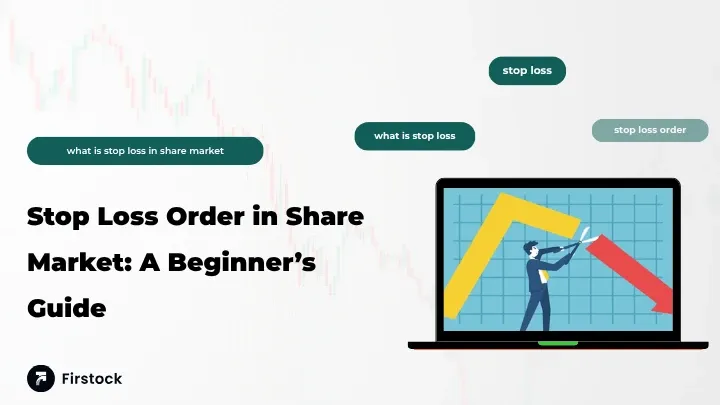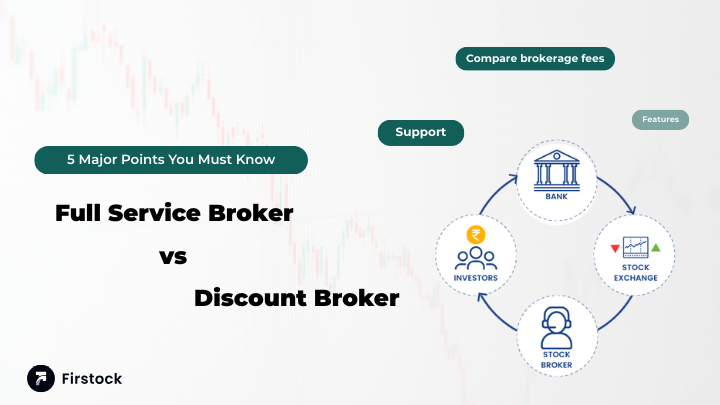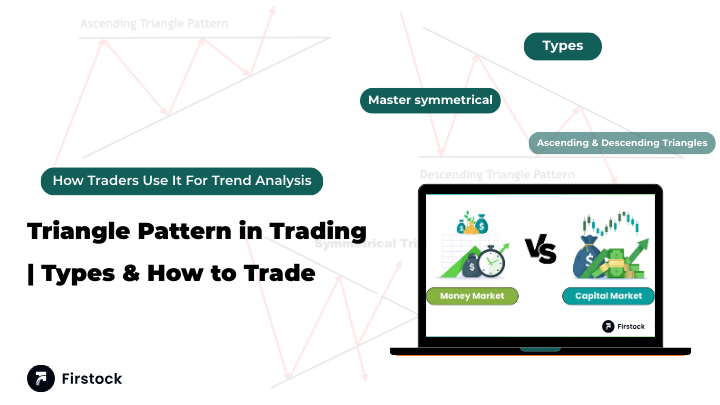Stop Loss Order in Share Market: A Beginner’s Guide

What Is Stop Loss in Share Market? The Ultimate Beginner’s Guide to Managing Risk
Imagine this — you’ve bought a stock that you knew would go up.But instead of rising, it keeps falling. You tell yourself, “It’ll bounce back soon,” and keep holding on.
Days later, your losses have doubled — and now, selling feels painful.
This is where the magic of a stop loss comes in. It’s like a safety net that protects you when the market doesn’t move in your favor.
In this guide, we’ll explain what is stop loss in share market, how it works, why it’s essential for every trader and investor, and how platforms like Firstock make using stop loss simple and effective.
What Is Stop Loss in Share Market?
A stop loss is a trading order designed to automatically sell (or buy) a stock when it reaches a certain price level — preventing further loss.
In simple terms:
A stop loss helps you control how much you’re willing to lose if the trade goes wrong.
Let’s take an example:
- You buy Infosys shares at ₹1,600.
- You decide you don’t want to lose more than ₹100 per share.
- You set a stop loss at ₹1,500.
If the price drops to ₹1,500, your stop loss order triggers, automatically selling your shares — limiting your loss to ₹100 per share.
That’s the power of a stop loss: it helps you trade with discipline, not emotions.
What Is Stop Loss — In Simple Words
The stop loss meaning is right in its name — it “stops your losses” before they grow out of control.
Think of it like:
- Wearing a seatbelt while driving
- Installing antivirus software on your computer
- Setting a monthly budget for expenses
You hope you never need it, but when things go wrong, it protects you.
In trading, emotions often lead to bad decisions — fear, greed, overconfidence. A stop loss in stock market acts as your rational guardian, cutting losses before emotions take over.
How Does Stop Loss Work?
Here’s how it actually functions inside the trading system:
- You place a stop loss order when entering a trade.
- You specify a trigger price — the level at which your stop loss activates.
- If the stock hits that price, the system automatically places a market or limit order to exit your position.
There are two common types of stop loss orders:
Tip: SL-M ensures execution; SL-L gives control over price — choose based on market volatility.
Why Stop Loss Matters So Much
Many beginners skip stop losses thinking, “I’ll just watch my stocks closely.”But markets move faster than you think — one bad news event can crash a stock within minutes.
Here’s why using stop loss is crucial:
At Firstock, traders often use stop loss orders as part of their core risk management system — ensuring their strategy remains intact even during volatile sessions.
Example: How Stop Loss Works in Real Life
Let’s understand this with a real-world illustration.
You buy 100 shares of TCS at ₹4,000. You decide that a 5% loss is your maximum tolerance.
So, your stop loss = ₹4,000 – (5% of ₹4,000) = ₹3,800.
If TCS falls to ₹3,800, your shares are automatically sold — limiting your total loss to ₹20,000.
Now imagine you didn’t set a stop loss, and the stock fell to ₹3,500. Your loss? ₹50,000.
That’s more than double what you could’ve prevented — all because of one missing order.
Stop Loss vs No Stop Loss: The Difference
As every seasoned trader will tell you —
“If you don’t respect stop loss, the market will teach you why you should.”
Stop Loss in Different Market Scenarios
Stop losses aren’t just for one kind of trading — they’re useful across the board:
1. Intraday Trading
Prices move quickly within hours. A stop loss order ensures that a small intraday mistake doesn’t become a big disaster.
2. Swing or Positional Trading
If you hold stocks for days or weeks, stop loss helps you survive market corrections.
3. Futures & Options
Highly leveraged instruments — a small move can cause huge loss. That’s why stop loss in stock market derivatives is absolutely non-negotiable.
4. Long-Term Investing
Even long-term investors use stop loss levels to protect against sudden market crashes.
Disclaimer: While stop loss helps minimize losses, it doesn’t guarantee profit or eliminate all risks. Sudden price gaps can still affect execution.
Common Mistakes Traders Make with Stop Loss
Even though stop losses are simple, many people misuse them. Here are the biggest errors to avoid:
- Setting Too Tight Stop Losses
- If you set them too close, even minor price fluctuations trigger exits unnecessarily.
- Not Adjusting Stop Losses
- When your trade moves in profit, move your stop loss upward (called trailing stop loss).
- Ignoring Market Volatility
- A volatile stock needs a wider stop loss; a stable one can have a tighter range.
- Using Round Numbers
- Everyone uses levels like ₹100 or ₹500. Market makers know this. Place your stop slightly above or below such levels.
- Not Planning Before Trade
- Decide your stop loss before entering, not after losses begin.
What Is Trailing Stop Loss?
A trailing stop loss moves automatically as the stock price moves in your favor.
Example:
- You buy a stock at ₹1,000.
- You set a trailing stop loss of ₹50.
- If the stock rises to ₹1,100, your stop loss shifts to ₹1,050.
- If the stock hits ₹1,200, stop loss moves to ₹1,150.
This helps lock in profits while still protecting against reversal.
It’s like having your cake and eating it too — securing gains while staying in the game.
How to Place Stop Loss Orders in Firstock
On the Firstock trading app, setting a stop loss is quick and beginner-friendly:
- Select the stock you wish to trade.
- Choose “Stop Loss” or “SL” as order type.
- Enter your trigger price and limit price (if using SL-L).
- Confirm and place the order.
That’s it — the system will monitor the market and execute automatically when conditions match.
Such tools make risk management effortless, even for first-time traders.
Stop Loss Strategies for Beginners
Here are some simple, practical methods to set effective stop losses:
1. Percentage Method
Decide a fixed percentage you’re willing to lose — usually 2–5% per trade.
2. Support and Resistance Method
Identify the nearest support level — place your stop just below it. This works well with technical analysis.
3. Volatility-Based Stop Loss
Use indicators like Average True Range (ATR) to set dynamic stop losses based on market movement.
4. Capital-Based Stop Loss
Limit your loss per trade to a percentage of your total capital (e.g., 1–2% of account size).
These strategies ensure you’re not just guessing your stop loss levels but basing them on logic and data.
Benefits of Using Stop Loss
Real-Life Example
Let’s say Ravi, a new trader, starts using Firstock. He buys shares of HDFC Bank at ₹1,600. Earlier, he used to hold losing trades hoping they’d recover.
This time, he places a stop loss order at ₹1,550.
When prices fall sharply during market volatility, his stop loss triggers — saving him from a bigger loss as the stock falls to ₹1,480 later that day.
That one small decision — setting a stop loss — protected his capital and confidence.
Limitations of Stop Loss
While stop losses are powerful, they aren’t perfect.
- Price Gaps: If a stock opens much lower than your stop loss level, it might execute at a worse price.
- Market Noise: Short-term volatility can trigger stops prematurely.
- Dependence on Discipline: Setting it is easy; sticking to it is hard.
That’s why seasoned traders combine stop loss with position sizing and risk management tools — a habit platforms like Firstock actively promote through their educational resources.
Conclusion: Stop Loss — The Unsung Hero of Trading
Every successful trader, from beginner to professional, understands one truth:
The key to winning isn’t making profits every time — it’s protecting your capital when things go wrong.
That’s exactly what stop loss helps you do.
It builds discipline, controls emotions, and ensures that a single bad trade doesn’t wipe out weeks of effort.
With modern trading platforms like Firstock, placing and managing stop loss orders is easier than ever — empowering you to trade smarter, not riskier.
Disclaimer: This content is for educational purposes only and does not constitute investment advice. All trading involves risk, and past performance is not indicative of future results.
FAQs on Stop Loss in Share Market
1. What is stop loss in share market?
A stop loss is an automatic order that sells your stock when it reaches a preset price — limiting your loss.
2. What is stop loss in stock market trading terms?
It’s a risk management tool used by traders to prevent excessive losses by triggering a sale automatically.
3. What is a stop loss order?
A stop loss order instructs your broker to sell (or buy) a security when it hits a specific trigger price.
4. Is stop loss only for selling?
No. You can also use it to buy in short-selling positions — to exit if the stock rises above your stop level.
5. Is using stop loss necessary?
While optional, it’s strongly recommended. It’s one of the most effective tools for risk management.
6. Does stop loss guarantee no loss?
No, but it limits losses. In fast-moving or gap-down markets, execution prices may vary slightly.
7. Can I change my stop loss later?
Yes, you can modify or trail your stop loss anytime before it’s triggered.





